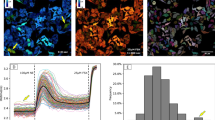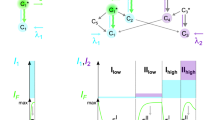Abstract
Fluorescent proteins that exhibit Förster resonance energy transfer (FRET) have made a strong impact as they enable measurement of molecular-scale distances through changes in fluorescence1. FRET-based approaches have enabled otherwise intractable measurements of molecular concentrations2, binding interactions3 and catalytic activity4, but are limited by the dynamic range and sensitivity of the donor-acceptor pair. To address this problem, we applied a quantitative evolutionary strategy using fluorescence-activated cell sorting to optimize a cyan-yellow fluorescent protein pair for FRET. The resulting pair, CyPet-YPet, exhibited a 20-fold ratiometric FRET signal change, as compared to threefold for the parental pair. The optimized FRET pair enabled high-throughput flow cytometric screening of cells undergoing caspase-3–dependent apoptosis. The CyPet-YPet energy transfer pair provides substantially improved sensitivity and dynamic range for a broad range of molecular imaging and screening applications.
This is a preview of subscription content, access via your institution
Access options
Subscribe to this journal
Receive 12 print issues and online access
$209.00 per year
only $17.42 per issue
Buy this article
- Purchase on Springer Link
- Instant access to full article PDF
Prices may be subject to local taxes which are calculated during checkout


Similar content being viewed by others
References
Tsien, R.Y. The green fluorescent protein. Annu. Rev. Biochem. 67, 509–544 (1998).
Miyawaki, A. et al. Fluorescent indicators for Ca2+ based on green fluorescent proteins and calmodulin. Nature 388, 882–887 (1997).
Chan, F.K. et al. Fluorescence resonance energy transfer analysis of cell surface receptor interactions and signaling using spectral variants of the green fluorescent protein. Cytometry 44, 361–368 (2001).
Jones, J., Heim, R., Hare, E., Stack, J. & Pollok, B.A. Development and application of a GFP-FRET intracellular caspase assay for drug screening. J. Biomol. Screen. 5, 307–318 (2000).
Rizzo, M.A., Springer, G.H., Granada, B. & Piston, D.W. An improved cyan fluorescent protein variant useful for FRET. Nat. Biotechnol. 22, 445–449 (2004).
Jensen, K.K., Martini, L. & Schwartz, T.W. Enhanced fluorescence resonance energy transfer between spectral variants of green fluorescent protein through zinc-site engineering. Biochemistry 40, 938–945 (2001).
Van Der Meer, B.W., Coker, G. & Chen, S.Y.S. Resonance Energy Transfer Theory and Data (VCH Publishers, New York, 1994).
Pollok, B.A. & Heim, R. Using GFP in FRET-based applications. Trends Cell Biol. 9, 57–60 (1999).
Campbell, R.E. et al. A monomeric red fluorescent protein. Proc. Natl. Acad. Sci. USA 99, 7877–7882 (2002).
Nagai, T. et al. A variant of yellow fluorescent protein with fast and efficient maturation for cell-biological applications. Nat. Biotechnol. 20, 87–90 (2002).
Rekas, A., Alattia, J.R., Nagai, T., Miyawaki, A. & Ikura, M. Crystal structure of venus, a yellow fluorescent protein with improved maturation and reduced environmental sensitivity. J. Biol. Chem. 277, 50573–50578 (2002).
Voigt, C.A., Kauffman, S. & Wang, Z.G. Rational evolutionary design: the theory of in vitro protein evolution. Adv. Protein Chem. 55, 79–160 (2000).
Heim, R. & Tsien, R.Y. Engineering green fluorescent protein for improved brightness, longer wavelengths and fluorescence resonance energy transfer. Curr. Biol. 6, 178–182 (1996).
Lakowicz, J.R. Principles of fluorescence spectroscopy, edn. 2 (Kluwer Academic/Plenum Publishers, New York, 1999).
Georgiou, G. Analysis of large libraries of protein mutants using flow cytometry. Adv. Protein Chem. 55, 293–315 (2000).
Boder, E.T. & Wittrup, K.D. Optimal screening of surface-displayed polypeptide libraries. Biotechnol. Progr. 14, 55–62 (1998).
Xu, X. et al. Detection of programmed cell death using fluorescence energy transfer. Nucleic Acids Res. 26, 2034–2035 (1998).
Takemoto, K., Nagai, T., Miyawaki, A. & Miura, M. Spatio-temporal activation of caspase revealed by indicator that is insensitive to environmental effects. J. Cell Biol. 160, 235–243 (2003).
He, L. et al. Flow cytometric measurement of fluorescence (Forster) resonance energy transfer from cyan fluorescent protein to yellow fluorescent protein using single-laser excitation at 458 nm. Cytometry 53, 39–54 (2003).
Ness, J.E. et al. Synthetic shuffling expands functional protein diversity by allowing amino acids to recombine independently. Nat. Biotechnol. 20, 1251–1255 (2002).
Bessette, P.H., Mena, M.A., Nguyen, A.W. & Daugherty, P.S. Construction of designed protein libraries using gene assembly mutagenesis. in Directed Evolution Library Creation Methods and Protocols, vol. 231 (eds. Arnold, F.H. & Georgiou, G.) 29–37, (Humana Press, Totowa, 2003).
Shapiro, H.M. & Perlmutter, N.G. Violet laser diodes as light sources for cytometry. Cytometry 44, 133–136 (2001).
Stemmer, W.P., Crameri, A., Ha, K.D., Brennan, T.M. & Heyneker, H.L. Single-step assembly of a gene and entire plasmid from large numbers of oligodeoxyribonucleotides. Gene 164, 49–53 (1995).
Guzman, L.M., Belin, D., Carson, M.J. & Beckwith, J. Tight regulation, modulation, and high-level expression by vectors containing the arabinose PBAD promoter. J. Bacteriol. 177, 4121–4130 (1995).
Fromant, M., Blanquet, S. & Plateau, P. Direct random mutagenesis of gene-sized DNA fragments using polymerase chain reaction. Anal. Biochem. 224, 347–353 (1995).
Miyazaki, K. & Takenouchi, M. Creating random mutagenesis libraries using megaprimer PCR of whole plasmid. Biotechniques 33, 1033–1038 (2002).
Reid, B.G. & Flynn, G.C. Chromophore formation in green fluorescent protein. Biochemistry 36, 6786–6791 (1997).
Miller, A.D., Miller, D.G., Garcia, J.V. & Lynch, C.M. Use of retroviral vectors for gene transfer and expression. Methods Enzymol. 217, 581–599 (1993).
Miller, A.D. & Rosman, G.J. Improved retroviral vectors for gene transfer and expression. Biotechniques 7, 980–990 (1989).
Acknowledgements
We wish to acknowledge E. Lipman for helpful discussions, A. Mikhailovsky and D. Korystov for lifetime measurement assistance and P. Bessette for critically reading the manuscript. We further acknowledge the generous support of this project by the National Institutes of Health-National Institute of Biomedical Imaging and Bioengineering grant EB-000205 and a National Science Foundation graduate fellowship to A.W.N.
Author information
Authors and Affiliations
Corresponding author
Ethics declarations
Competing interests
The authors declare no competing financial interests.
Supplementary information
Supplementary Fig. 1
Sorting the synthetically shuffled CFP library (Library 4) for high CFP fluorescence and high FRET-on signal. (PDF 1023 kb)
Supplementary Fig. 2
Fluorescence decay data of fluorescent protein variants. (PDF 358 kb)
Supplementary Fig. 3
Locations of amino acid substitutions in the FRET optimized variants CyPet and YPet. (PDF 695 kb)
Supplementary Fig. 4
Native protein electrophoresis of fluorescent protein variants. (PDF 1170 kb)
Supplementary Fig. 5
Concentration dependent FRET between donor and acceptor pairs. (PDF 69 kb)
Supplementary Table 1
Fluorescence lifetime analysis of CFP and YFP variants (DOC 36 kb)
Rights and permissions
About this article
Cite this article
Nguyen, A., Daugherty, P. Evolutionary optimization of fluorescent proteins for intracellular FRET. Nat Biotechnol 23, 355–360 (2005). https://doi.org/10.1038/nbt1066
Received:
Accepted:
Published:
Issue Date:
DOI: https://doi.org/10.1038/nbt1066
This article is cited by
-
Near-infrared co-illumination of fluorescent proteins reduces photobleaching and phototoxicity
Nature Biotechnology (2023)
-
The role of polymeric chains as a protective environment for improving the stability and efficiency of fluorogenic peptide substrates
Scientific Reports (2022)
-
A method for Boolean analysis of protein interactions at a molecular level
Nature Communications (2022)
-
Adolescent sleep shapes social novelty preference in mice
Nature Neuroscience (2022)
-
Mechanistic dissection of increased enzymatic rate in a phase-separated compartment
Nature Chemical Biology (2021)



